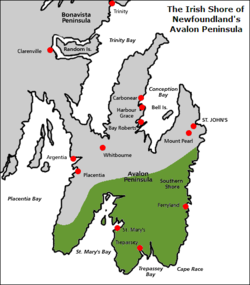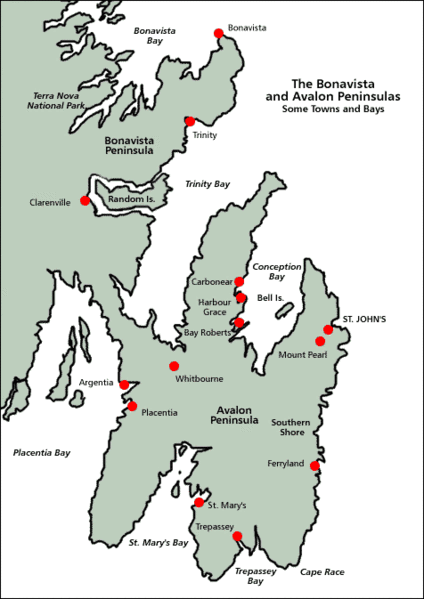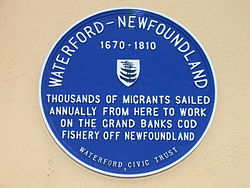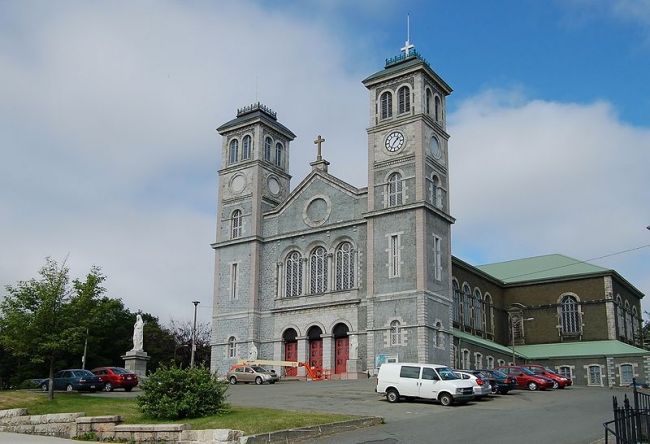| Irish Forums Message Discussion :: Videos of Irish emigrants in Newfoundland Canada |
   | Irish Forums :: The Irish Message
Forums About Ireland and the Irish Community, For the Irish home and Abroad. Forums include- Irish Music, Irish History, The Irish Diaspora, Irish Culture, Irish Sports, Astrology, Mystic, Irish Ancestry, Genealogy, Irish Travel, Irish Reunited and Craic
|  
|
Videos of Irish emigrants in Newfoundland Canada
 

|
|
|
| Irish
Author |
Videos of Irish emigrants in Newfoundland Canada Sceala Irish Craic Forum Irish Message |
|
Irish hal
Sceala Philosopher
Location: Carnew
|
| Sceala Irish Craic Forum Discussion:
Videos of Irish emigrants in Newfoundland Canada
|
|
|
The Avalon Peninsula is a wonderful place. If you get to Canada try and make a visit. St Johns is a real good place to stay.
Newfoundland has to be the most Irish place outside of Ireland. More Irish than many Irish in Ireland are today, that's for sure.
No other expatriate Irish community outside Ireland can claim such extensive and persistent ethnic, cultural, political, and religious forms as similar to those of Ireland.
Videos of Irish emigrants in Newfoundland Canada
The videos are made in Ireland and Newfoundland, they show the strong Irish connections in Newfoundland Canada
Irish Newfoundlanders
Newfoundland and Ireland
In modern Newfoundland, many Newfoundlanders are of Irish descent. According to the Statistics Canada 2006 census, 21.5% of Newfoundlanders claim Irish ancestry on at least one side of their family tree. The family names, the features and colouring, the predominant Catholic religion in some areas (particularly on the southeast portion of the Avalon Peninsula), the prevalence of Irish music – even the accents of the people in these areas – are so reminiscent of rural Ireland that Irish author Tim Pat Coogan has described Newfoundland as "the most Irish place in the world outside of Ireland".
History of Newfoundland Irish
The Irish migrations to Newfoundland, and the associated provisions trade, represent the oldest and most enduring connections between Ireland and North America. As early as 1536, the ship Mighel (Michael) of Kinsale is recorded returning to her home port in County Cork with consignments of Newfoundland fish and cod liver oil. A further hint of what one scholar has termed a diaspora of Irish fishermen dates from 1608, when Patrick Brannock, a Waterford mariner, was reported to sail yearly to Newfoundland. Beginning around 1670, and particularly between 1750 and 1830, Newfoundland received large numbers of Irish immigrants.
Approximate location of the 'Irish Shore' on the Avalon Peninsula.

These migrations were seasonal or temporary. Most Irish migrants were young men working on contract for English merchants and planters. It was a substantial migration, peaking in the 1770s and 1780s when more than 100 ships and 5,000 men cleared Irish ports for the fishery. The exodus from Ulster to the USA excepted, it was the most substantial movement of Irish across the Atlantic in the 18th century. Some went on to other North American destinations, some stayed, and many engaged in what has been called "to-ing and fro-ing", an annual seasonal migration between Ireland and Newfoundland due to fisheries and trade. As a result, the Newfoundland Irish remained in constant contact with news, politics, and cultural movements back in Ireland.

Virtually from its inception, a small number of young Irish women joined the migration. They tended to stay and marry overwintering Irish male migrants. Seasonal and temporary migrations slowly evolved into emigration and the formation of permanent Irish family settlement in Newfoundland. This pattern intensified with the collapse of the old migratory cod fishery after 1790. An increase in Irish immigration, particularly of women, between 1800-1835, and the related natural population growth, helped transform the social, demographic, and cultural character of Newfoundland.
In 1836, the government in St. John's commissioned a census that exceeded in its detail anything recorded to that time. More than 400 settlements were listed. The Irish, and their offspring, composed half of the total population. Close to three-quarters of them lived in St. John's and its near hinterland, from Renews to Carbonear, an area still known as the Irish Shore. There were more Catholic Irish concentrated in this relatively restricted stretch of shore than in any comparable location in Canada.
Location of Newfoundland Irish
Plaque in Waterford, Ireland

The vast majority of Irish came from the counties of Wexford, Carlow, Kilkenny, Tipperary, Waterford, Dingle, in Kerry, and Cork. No other province in Canada or state in the USA drew such an overwhelming proportion of their immigrants from so geographically compact an area in Ireland over so prolonged a period of time.
Waterford city was the primary port of embarkation. Most migrants came from within a day's journey to the city, or its outport at Passage, 10 km (6 mi) down river in Waterford Harbour. They were drawn from parishes and towns along the main routes of transport and communication, both river and road, converging on Waterford and Passage. New Ross and Youghal were secondary centers of transatlantic embarkation. Old river ports such as Carrick on Suir and Clonmel on the River Suir, Inistioge and Thomastown on the River Nore, and Graiguenamanagh on the River Barrow were important centers of recruitment. So were the rural parishes along these navigable waterways.
Probably the principal motivation for migration was economic distress in the homeland. The population almost doubled between 1785-1835, the main period of emigration. Land scarcity, unemployment, underemployment, and the promise of higher wages attracted young Irishmen to Newfoundland. Irrespective of economic or social origins, almost all Irish moved primarily to better their economic lot.
Religion of Newfoundland Irish
Central to their lives and culture to the Irish was their religious faith; institutional religion served as the pivot for a great deal of Irish life in Newfoundland. Several of the leading Irish merchants and propertied men were Protestants and brought the traditions of the Orange Order to their new home. However, the majority of the Irish were Roman Catholics and many sought to recreate in Newfoundland the institutional Roman Catholicism which they had known in Ireland. As a result, the institutional church which emerged over the next 50 years became the single most important ethnic, social and cultural institution for the Irish in Newfoundland, and its various clergy and leaders were the de-facto leaders of the Irish community in Newfoundland.
Rebellion of Newfoundland Irish
In 1800, a cell of the Society of the United Irishmen was uncovered in the St. John's Garrison and planned to rebel against the English authority in the United Irish Uprising, making Newfoundland one of the few places outside Ireland in which the Irish Rebellion of 1798 had political effects. Even at the time of the Napoleonic Wars, political activism rooted in Irish agrarian movements manifested themselves in Newfoundland, in such forms such as the Caravats (who wore French 'cravates' or ties), and the Shanavests (literally, the 'old vests'). Indeed, no other expatriate Irish community outside Ireland can claim such extensive and persistent ethnic, cultural, political, and religious forms as similar to those of Ireland.
BIS building, St. Patrick's Hall, St. John's, Newfoundland
Benevolent Irish Society
In the early years of the 19th century, St. John's had a large Irish population with some members of affluence. It was a town with growing influence, and was the cradle of growing cultural and political ferment. Many of these Irish both saw social needs which were not being met by government, and desired to belong to a fraternal, gentlemanly organization. In 1806, under Bishop O'Donel's patronage, they founded the Benevolent Irish Society (the BIS) as a charitable, non-profit, non-sectarian society for Irish-born men under the motto "He who gives to the poor lends to the Lord." In 1823 the BIS collected a subscription and opened a non-sectarian school in St. John's, the Orphan Asylum, for the education of the Irish poor.
Irish fraternities of Newfoundland Irish
Outside the Benevolent Irish Society (BIS), there were two fraternal organizations to which Irish Catholics in Newfoundland belonged. The earliest to be established in Newfoundland was the Irish Mechanics' Society, organized in March 1827. The Mechanics' Society was established as a self-help and educational society by four skilled tradesmen, Patrick Kelly, Edmond Power, Louis Martin, and William Walsh. The Society provided a meeting place and educational opportunities for its members, a sickness insurance scheme, and a program of benefits for injured members or the families of deceased members. Many of the early members of the Mechanics' Society were Irish Catholics from St. John's, but intra-Irish county origins, and membership in Irish provincial factions — the Tipperary Clear Airs, the Wexford Yellowbellies, the Waterford Wheybellies, the Kilkenny Doones, and the Cork Dadyeens may also have played a part in determining its membership. Like the Benevolent Irish Society, the rules of the Mechanics' Society prohibited members from formally discussing political or religious questions, but the Society occasionally took a public political stand. In 1829 it participated in a large parade through St. John's to celebrate Roman Catholic Emancipation. Many of its early leaders became prominent in political life.
The Irish temperance movement was founded in Cork, Ireland in April 1838 by the Franciscan priest, Father Theobald Mathew. In 1841 the movement was introduced to St. John's by Father Kyran Walsh. During the 1840s and into the 1860s, the Newfoundland Temperance Society became one of the most popular working class fraternal organizations in St. John's. In the context of Irish culture and politics, the Irish temperance movement in Newfoundland also became a political forum for lobbying for the repeal of the union of Ireland with Britain, particularly during the Repeal Year of 1843. By 1844, over 10,000 members had enrolled and by the late 19th century, the society developed a substantial membership and social presence in St. John's. In the early 20th century, the society became renowned for its literary and musical events, and remained one of the most active and influential fraternal societies in St. John's until the 1990s.
Irish Catholic religious orders of Newfoundland Irish
As the permanent population, and the numbers of young people and children in Newfoundland increased during the early 19th century, public interest in access to education also grew. Bishop Michael Anthony Fleming understood both the parental aspirations for education, and the religious opportunities that it presented. He was determined to provide "cradle-to-grave" cultural institutions for Irish Roman Catholics and in particular, wanted to address the needs and aspirations of working class Catholics. He actively recruited religious orders of women from Ireland to deliver the educational and religious program for the Church.
In March 1833, Bishop Fleming went to Galway, Ireland, where he sought several sisters of the order of the Presentation of the Blessed Virgin Mary to come to Newfoundland and open a school for female children. Several years later while the Presentation sisters had a considerable influence on the Irish community in St. John's, Fleming desired to extend Catholic education further. In 1839, he decided to invite a second order of religious Irish women to Newfoundland, the Sisters of Mercy. Together, the work of the Presentation sisters and the Sisters of Mercy became the centrepiece of Catholic education in Newfoundland for the next century and a half, and a cornerstone of the denominational education system. Their skills and talents were recognized by all denominations, and over the next century they and their convents were sought out by parents of all denominations as centres of excellence in the arts, learning, and particularly, music.
In the 1847, Bishop Fleming recruited four brothers of the order of Irish Christian Brothers, a lay religious order founded in Waterford by the merchant Edmund Rice, to come to Newfoundland to teach at the Benevolent Irish Society's school.
Newfoundland Irish Building a cathedral
The rapid growth of the Irish population in St. John's during the early years of the 19th century necessitated several expansions to the Roman Catholic Chapel. By the mid-1830s, the Old Chapel had long outlived its usefulness and Bishop Fleming wished to construct a house of worship capable of holding his congregation. Construction was supervised by Bishop Fleming and later by his successor, Bishop John Mullock. Built between 1839-1855 of stone imported from Ireland, the Basilica of St. John The Baptist still stands.

The St. John's Basilica was contemporary with and part of the great boom in church construction which surrounded the age of Catholic Emancipation in Ireland and Newfoundland.
Culture of Newfoundland Irish
In Newfoundland, the Irish created a distinctive culture through the 18th century that is still evident. Almost all were Catholic. To Newfoundland, the Irish gave the still-familiar family names of southeast Ireland: Wade, McCarthy, O'Rourke, Walsh, Power, Murphy, Ryan, Griffin, Whelan, O'Brien, Kelly, Hanlon, Neville, Bambrick, Halley, Dillon, Byrne, Lake and FitzGerald. Irish place names are less common, many of the island's more prominent landmarks having already been named by early French and English explorers. Nevertheless, Newfoundland's Ballyhack, Cappahayden, Kilbride, St. Bride's, Placentia, Port Kirwan, Duntara and Skibbereen all point to Irish antecedents.
Along with traditional names, the Irish brought their native tongue. Many spoke only Irish on arrival (which gave rise to a dialect of the Irish language known as Newfoundland Irish), or distinctive varieties of English. Newfoundland is one of the few places outside Ireland where the Irish language was spoken by a majority of the population as their primary language. Newfoundland is the only place outside Europe with its own distinctive name in the Irish language, Talamh an Éisc (Land of the Fish). Elements of material culture — agricultural folkways, vernacular and ecclesiastical architecture, for example — endured to this day, and trace elements remain. But the strange new world of a commercial cod fishery and the presence of so many English transformed their lives; their descendants emerged as fully-fledged Newfoundlanders, a unique culture in modern North America.
Videos of Irish emigrants in Newfoundland Canada above
|
|
|
|
|
|
|
|
|
|












